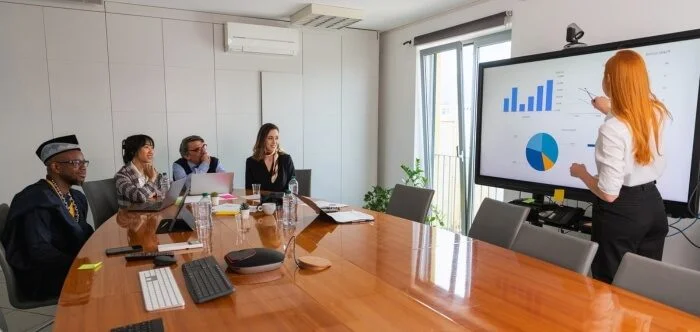When preparing for a conference, one crucial aspect often stumps even seasoned professionals: the presentation title. It’s a dilemma that can make or break the audience’s interest. So, “How do you title a conference presentation?”
The key is to craft a title that is concise yet impactful, one that conveys your topic while highlighting its importance. It should resonate with your audience, incorporating key terms relevant to your field and aligning with the conference’s theme. By doing this, you ensure your presentation stands out.
If you’re struggling with this, our blog offers a comprehensive guide, packed with examples and tips to craft a title that resonates with your audience. Dive into our post for more insights and take your conference presentation to the next level!
The Role of a Compelling Title in Attracting Audiences
Crafting a captivating title is akin to unlocking the door to a remarkable conference presentation, one that not only piques the interest of your audience but also lays the groundwork for an unforgettable experience, especially for those attending conferences internationally.

- First Impressions: Titles are the first thing attendees see. A well-crafted title instantly communicates your topic’s essence, making them eager to learn more.
- Relevance: They highlight your presentation’s significance and how it aligns with the audience’s interests and needs. This relevance creates a stronger connection.
- Engagement: A captivating title generates anticipation and excitement, encouraging more people to attend your presentation and actively participate.
- Information: It offers a glimpse of what to expect, helping attendees decide if your talk is worth their time. It’s a sneak peek into the knowledge you’ll share.
- Memorability: A catchy title is easier to remember, ensuring your presentation stays in attendees’ minds long after the conference. It leaves a lasting impression.
- Visibility: In conference programs and marketing materials, an eye-catching title stands out, increasing your presentation’s visibility and attracting a broader audience.
Crafting a compelling title is a strategic move that can make your conference presentation a resounding success. It’s the first step in engaging your audience and leaving a lasting impact.
Types of Titles You Can Implement in A Conference Presentation
The title of your conference presentation is your first chance to grab your audience’s attention and draw them in. It’s a crucial element that can determine the success of your talk. Here are several types of titles you can implement to make your presentation stand out:
Descriptive Titles
These titles provide a clear snapshot of your presentation’s content. They are straightforward and allow attendees to immediately understand what your talk is about. Descriptive titles are particularly useful when you want to convey specific information or findings.
Question Titles
Asking a thought-provoking question in your title can instantly engage your audience’s curiosity. It encourages them to attend your presentation in search of answers. Question titles are effective for sparking discussions and creating an interactive atmosphere.
Action-Oriented Titles
Titles that suggest your presentation will offer practical solutions, strategies, or takeaways can motivate attendees to participate. These titles imply that your talk will provide actionable insights, making it a valuable choice for those seeking tangible benefits.
Intriguing Statements
Bold or intriguing statements in your title can captivate your audience. They create a sense of intrigue and anticipation, compelling attendees to find out more. These titles work well when you want to challenge conventional thinking or present a unique perspective.
Audience-Centric Titles
Tailoring your title to address the specific pain points or goals of your audience can resonate deeply with them. It shows that your presentation is relevant to their needs and encourages attendance from those seeking solutions to their challenges.
Creative and Playful Titles
Injecting creativity, humor, or wordplay into your title can make your presentation memorable. These titles stand out from the crowd and add a touch of personality to your talk. However, be sure the creativity aligns with your presentation’s tone and content.
Each of these title types serves a unique purpose, and selecting the right one depends on your conference presentation’s content and the audience you aim to engage. Using different title styles can enhance your ability to connect with conference attendees and ensure your conference presentation contains the right elements.
Key Elements of A Successful Conference Presentation Title
The title of your conference presentation is the first thing your audience sees, and it’s your chance to make a strong impression. A successful title can greatly impact the effectiveness of your presentation. Here are the key elements to craft one:
Clarity and Conciseness
A successful title should be crystal clear, providing an immediate understanding of your presentation’s subject. It should be concise, avoiding unnecessary jargon or complexity. A straightforward title ensures that your audience knows what to expect.
Relevance to Audience
Consider your audience’s interests, needs, and pain points. A successful title should resonate with them, addressing their specific concerns and showing how your presentation will provide value or solutions. Tailoring your title to your audience can enhance engagement.
Engagement Factor
Titles that engage the audience by sparking curiosity or emotion are more likely to succeed. Use words that pique interest and excitement, such as “Unlocking,” “Discovering,” or “Revolutionizing.” An engaging title sets the stage for an enthusiastic audience.
Keyword Inclusion
Incorporating relevant keywords or phrases related to your presentation’s topic or field can improve searchability and ensure that your title aligns with the content. It helps potential attendees find your presentation when browsing conference programs or schedules.
Alignment with Content
A successful title accurately represents the content of your presentation. Misleading titles can lead to disappointed attendees and a lack of trust. Ensure that your title delivers on its promises by reflecting the core message of your presentation.
Memorability
Crafting a memorable title is essential. It should be distinctive and impactful, making it easier for your audience to remember and recall your presentation long after the conference. A memorable title can contribute to the lasting impact of your work.
By carefully considering and incorporating these key elements into your conference presentation title, you can increase its effectiveness in attracting and engaging your audience. Your title serves as the first impression of your presentation, so make it count by capturing the essence of what you have to offer.
How Do You Title a Conference Presentation?
Choosing the perfect title for your conference presentation is a critical step in capturing your audience’s attention and conveying the essence of your work. Here’s a step-by-step guide on how do you title a conference presentation.
Step-1. Understand Your Audience and Theme
Begin by thoroughly researching your target audience. Understand their demographics, interests, and expectations. Additionally, dive into the overarching theme of the conference, identifying key topics and trends. This foundational knowledge will guide your title selection.
Step-2. Highlight the Main Message
In a few words, your title should summarize the central message or key takeaway from your presentation. Consider what valuable insights or knowledge you aim to share. Your title should be a concise preview of the value your presentation offers.
Step-3. Use Keywords and Phrases
Research and identify relevant keywords and phrases related to your presentation topic. Incorporate these strategically into your title to enhance its discoverability in conference materials and online promotions. These keywords will help potential attendees find your presentation amidst a sea of options.
Step-4. Be Engaging and Intriguing
Craft your title with an eye toward engagement. Use rhetorical devices such as questions, metaphors, or intriguing statements to spark curiosity. Make it clear that your presentation offers a fresh perspective or addresses a pressing issue. An engaging title can set a positive tone for your entire presentation.
Step-5. Keep It Concise
While it’s important to convey your message effectively, avoid overcomplicating your title. Aim for brevity and clarity. A concise title, ideally under 15 words, is more likely to stick in attendees’ minds and make a lasting impression. Ensure that your title remains relevant to your presentation content; avoid misleading or overly sensational titles.
Step-6. Review and Revise
After drafting your title, take the time to review and refine it. Seek input from colleagues or peers who are familiar with your topic and the conference’s context. Their feedback can help you fine-tune your title to perfection, making it more appealing and aligning it precisely with your presentation’s content and goals.
By following these six steps, you can craft a conference presentation title that not only captures the essence of your talk but also resonates with your audience, increasing the likelihood of a successful and well-attended presentation.
Typical Errors to Avoid While Titling a Conference Presentation
When crafting the title for your conference presentation, be mindful of these common errors that can affect your title’s effectiveness:
- Lack of clarity: Steer clear of titles that are unclear or overly general. Attendees should immediately understand the topic and purpose of your presentation.
- Jargon Overload: While expertise is important, avoid overwhelming your audience with excessive technical jargon. Strive for a balance that caters to both specialists and general attendees.
- Overly Long Titles: Lengthy titles can be off-putting and difficult to remember. Aim for brevity, keeping your title concise and to the point.
- Lack of Relevance: Ensure that your title directly relates to the content you’ll present. A misleading title can lead to disappointed or disinterested attendees.
- Sensationalism: Resist the temptation to use sensational language in your title. Be honest about what your presentation offers to avoid creating unrealistic expectations.
- Misspellings and Errors: Proofread your title meticulously to eliminate spelling and grammatical mistakes. Errors can diminish your professionalism and credibility.
Effective presentation titles play a pivotal role in attracting an audience. By avoiding these common pitfalls, you can create a title that genuinely engages and informs potential attendees.
Essential Tips for Crafting Effective Conference Presentation Title
Creating a compelling conference presentation title is crucial to capturing your audience’s attention and conveying the essence of your talk. Here are some essential tips to help you craft a title that stands out:
Know Your Audience and Theme
Begin by thoroughly researching your target audience, including their interests and expectations. Familiarize yourself with the conference’s overarching theme, ensuring your title aligns with it. This understanding will guide your title selection.
Highlight the Main Message
In just a few words, your title should not only encapsulate the central message or key takeaway from your presentation but also highlight its practical significance. Consider what valuable insights or knowledge your audience will gain from attending your talk and why it matters in their context.
Incorporate Relevant Keywords
Identify and include relevant keywords and phrases related to your presentation topic. This not only enhances discoverability but also ensures your title resonates with attendees searching for specific content. Think about the language your target audience uses when seeking information.
Engage and Intrigue Your Audience
Craft a title that piques curiosity and generates interest. Utilize rhetorical devices such as questions, metaphors, or compelling statements to stimulate your audience’s curiosity and convey the uniqueness of your presentation.
Keep It Concise and Clear
Aim for clarity and brevity in your title while providing enough information to convey your presentation’s essence. Short, memorable titles, preferably under 15 words, are more effective. Avoid complex language and acronyms that may confuse or deter potential attendees. Make sure your title communicates what your presentation is about.
Review and Refine
After drafting your title, seek feedback from colleagues or peers familiar with your topic and the conference’s context. Their input can help you fine-tune your title to make it more appealing and align it precisely with your presentation’s content and objectives.
Crafting an effective conference presentation title requires careful consideration of your audience, message, keywords, engagement tactics, clarity, and iterative refinement. A well-crafted title not only attracts attendees but also sets the stage for a successful presentation.
Conclusion
In addressing “How do you title a conference presentation?”, the goal is to strike a balance between clarity and intrigue. A concise, impactful title not only grabs attention but also make understanding and sets the tone for the presentation.
Crafting the ideal title involves harmonizing with the audience’s interests, using relevant keywords, and mirroring the theme of the conference. This approach ensures that the title is memorable and accurately reflects your presentation’s main message.
It’s vital to avoid common errors such as using too much jargon or sensational language. A well-thought-out title does more than captivate; it truthfully represents your presentation’s content, setting up a meaningful and engaging experience for your audience.







